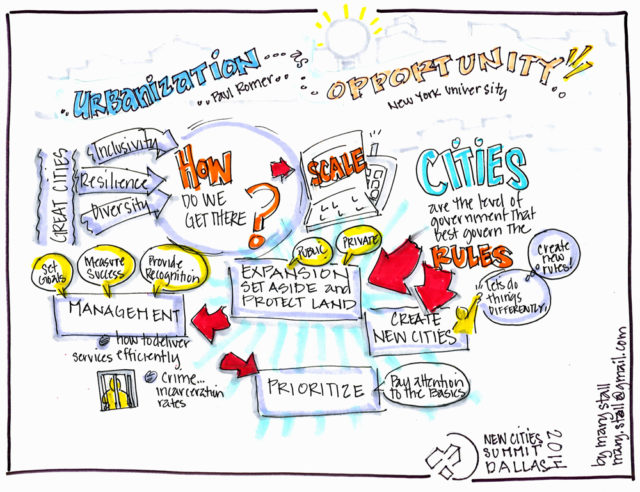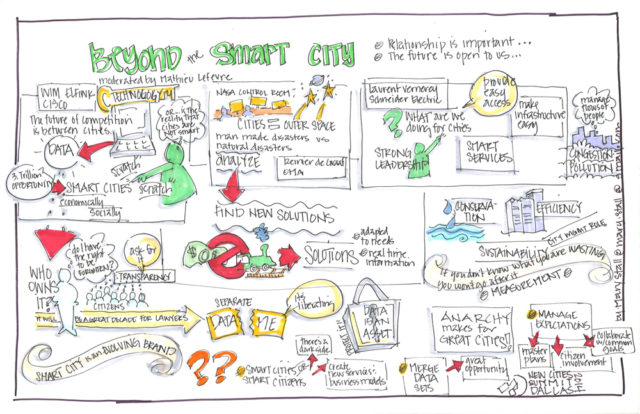
Why Urbanization Equals Opportunity
juin 19, 2014 — Uncategorized
The second day of the NewCities Summit was filled with activity. Thousands of tweets were exchanged during the various panel discussions. A young app developer, inspired by his house burning down, presented a sharing app that, by popular of Summit participant votes, nabbed the New Cities Foundation’s coveted AppMyCity! prize.
Later, six mayors, hailing from four continents, perched on two sofas and shared a remarkable number of points of view while eloquently summing up the summit’s overarching vision of cities reimagined and on the rise. But the New Cities’ Dallas edition wasn’t done yet: the day was capped off by gathering everyone at one of Dallas’ most famous honkytonks – Gilley’s – for plenty of boot scootin’ country music and line dancing.

Paul Romer, director of the Marron Institute at New York University, and one of the world’s leading urban economist, kicked off the summit’s final day with a keynote address where he urged urban leaders to be provocatively bold in addressing how cities’ priorities should be aligned.
“It’s better,” Romer advised, “To make statements that might be wrong instead of giving platitudes that we can all agree with.” The bottom line for Romer was simple: Public spaces are paramount, and urbanization equals opportunity.
It’s better to make statements that might be wrong instead of giving platitudes that we can all agree with – Paul Romer
The intersection of technology with the present and future of urban life was very much on the minds of Arun Bhikshesvaran, Chief Marketing Officer of Ericsson, and Matt Rogers, co-founder of Nest. Bhikshesvaran was armed with all sorts of striking numbers to describe the penetration of technology into urban settings, starting with the notion that, on average, most people, especially those in cities, interact 200 times a day with their smart phones. “And I can assure you that around 84 percent of Sao Paulo citizens use their smart phones while on their daily commute,” he added. “Most cities now are completely data centric worlds.”
Meanwhile, Rogers addressed the 800-pound gorilla in the technological room about the justifiable concern for security and privacy.“It’s incredibly important in whatever technological building that we do that it be done in a secure manner, and that sensitive data is kept private,” Rogers says. “And we do that by employing some of the best hackers around to keep the data base totally safe.”

The increasingly role of technology in urban life, and its implications on society, were further deliberated in a stimulating panel discussion that unpicked the term “smart city.” For Wim Elfrink, Executive Vice President of Industry Solutions and Chief Globalization Officer at Cisco, the next decade could potentially generate as much as an estimated $3 trillion dollars in global smart technology opportunities for cities.
Reinier de Graaf, a partner at OMA architects, shared his fascination, mixed with some skepticism, at Rio de Janeiro’s central urban operations control room, and how it bore a striking resemblance to a NASA mission control complex.
The participants were not afraid to question the term ‘smart city’ which has now become ubiquitous. Laurent Vernerey, Executive Vice President, North American operations, for Schneider Electric, suggested, “the smart city as a notion is about seven years old. It is a well-known brand by now but it probably has to evolve.” Then, de Graaf uttered one of the most provocative statements of the day: “This whole smart city expression…can start to feel like a cliché after a while. Why don’t we just get rid of the adjective and just talk about the ‘city.’”
This whole smart city expression…can start to feel like a cliché after a while. Why don’t we just get rid of the adjective and just talk about the ‘city’ – Reinier de Graaf
Exuberant, brilliant invention again ruled the Summit’s second WhatWorks session. Day two’s featured innovators included Gerardo Asali, behind pop-up public green spaces that liven up various Mexico City neighborhoods, or Scott Crouch’s Mark43 data sharing network designed to help urban police forces combat urban crime. There was also Meenu Vadera’s women on wheels driving and chauffeur enterprise, bringing countless Indian women into what has been traditionally a very biased workplace. “This pushes women further out of their homes and gives them control, rights and freedom,” Vadera said.
Following on from the Cultural Capital session on Day One, the Summit probed further into this topic with a discussion on cultural districts, with participants from Sharjah, Beijing and the US, moderated by Adrian Ellis, director of the Global Cultural Districts Network which is headquartered in the Dallas Arts District.
In the waning hours of the Summit’s final day, the three finalists of the AppMyCity! contest – selected from an initial pool of 100 competitors – presented their cutting edge, urban-centric apps. The entire Summit audience was given one minute to vote online for their favorite. And judging by the reaction to Daan Weddepohl’s description of his Peerby merchandise sharing app, born out of his losing all his worldly possessions in a house fire, he was the audience’s favorite to win the first prize of $5,000. And to the audience’s delight, he did. “We now have 50,000 people in Amsterdam sharing every day,” said the smiling Weddepohl. “I want to make every city of the world a sharing city.”
I want to make every city of the world a sharing city – Daan Weddepohl, Peerby

The day closed with a Town Hall panel comprising six mayors, from as near as Dallas and Fort Worth, to as far away as Johannesburg, San Sebastian, Harare, and Colombo. The six mayors spoke candidly about what “keeps them up at night” when it comes to concerns about their individual cities’ futures. And it was quite a sight to see six mayors from such different cities all nodding their heads in supportive unison as they each spoke about the importance of improving their cities’ record on education, public-private funding, healthcare, voter apathy and public safety.

The Mayor of Dallas, Mike Rawlings, highlighted how perfectly the Johannesburg mayor, Mpho Franklyn Parks Tau, had summed up the collaboration between Dallas and neighboring city Fort Worth. “His word, ‘coopertition’ – a combination of cooperation and competition – that says it all,” Rawlings exclaimed.
And then, in keeping with the New Cities Foundation’s tradition of closing its summit on a soothing musical note, ten members of the Turtle Creek Chorale, a famous Dallas-based all-male choir, assembled in front of the stage to sing five songs, including an uplifting rendition of the Beatles, “Yesterday” – a perfect melodic coda to this year’s New Cities Summit, whose gaze is firmly directed towards tomorrow.